I changed the startPoint/endPoint for the sake of the illustration.
This code can be used in XCode Playground. That's not the best Swifty code, but focus on logic/explanation rather than pure Swift code
Shared settings:
import Foundation
import UIKit
let viewsWidth: CGFloat = 300.0
let viewsHeight: CGFloat = 400.0
The way to fix you code is to modify locations:
let viewMain: UIView = UIView(frame: CGRect(x: 0, y: 0, width: viewsWidth, height: viewsHeight))
let color1 = UIColor(red: 0.0/255.0, green: 231.0/255.0, blue: 198.0/255.0, alpha: 0.9).cgColor
let color2 = UIColor(red: 0.0/255.0, green: 198.0/255.0, blue: 255.0/255.0, alpha: 0.9).cgColor
var gradientLayer = CAGradientLayer.init()
gradientLayer.frame = viewMain.bounds
gradientLayer.colors = [color2, color1, color1, color2]
gradientLayer.locations = [0.0, 0.2, 0.8, 1.0]
gradientLayer.startPoint = CGPoint(x: 0, y: 0.5)
gradientLayer.endPoint = CGPoint(x: 1, y: 0.5)
viewMain.layer.insertSublayer(gradientLayer, at: 0)
viewMain //That's just for the Show Result action in Playground
ViewMain:

Some explanations now.
Let's first draw a line at each of the locations:
let otherView = UIView(frame: viewMain.bounds)
if let locations = gradientLayer.locations, let colors = gradientLayer.colors {
for (index, aLocation) in locations.enumerated() {
let aLine = UIView(frame: CGRect(x: viewsWidth*CGFloat(aLocation.floatValue)-2,
y: 0,
width: 4,
height: viewsHeight))
aLine.backgroundColor = UIColor(cgColor: colors[index] as! CGColor)
otherView.addSubview(aLine)
}
}
otherView //That's just for the Show Result action in Playground
OtherView:

Now, let's draw a gradient, for each line, but only one (the rest of the colors is set to white to simplify).
if let locations = gradientLayer.locations, let colors = gradientLayer.colors {
let offset = 5
let bigView = UIView(frame: CGRect(x: 0,
y: 0,
width: viewsWidth * CGFloat(locations.count) + CGFloat(offset),
height: viewsHeight))
for (index, _) in locations.enumerated() {
let aGradientView = UIView(frame: CGRect(x: 0 + (viewsWidth + CGFloat(offset))*CGFloat(index),
y: 0,
width: viewsWidth,
height: viewsHeight))
let aGradientLayer = CAGradientLayer()
aGradientLayer.frame = aGradientView.bounds
var aGradientColors = [CGColor](repeating: UIColor.white.cgColor, count: colors.count)
aGradientColors[index] = colors[index] as! CGColor
aGradientLayer.colors = aGradientColors
aGradientLayer.locations = gradientLayer.locations
aGradientLayer.startPoint = CGPoint(x: 0.0, y: 0.5)
aGradientLayer.endPoint = CGPoint(x: 1.0, y: 0.5)
aGradientView.layer.insertSublayer(aGradientLayer, at: 0)
aGradientView.layer.borderColor = UIColor.black.cgColor
aGradientView.layer.borderWidth = 2.0
aGradientView.clipsToBounds = false
bigView.addSubview(aGradientView)
}
bigView //That's just for the Show Result action in Playground
}
BigView:

The illustration shown speak for itself.
At each "line" (exhibit 2), when you want to apply the gradient (exhibit 3), the color goes from that line until the next one. That's why your first locations were not giving the expected results. You need to put intermediary steps.




